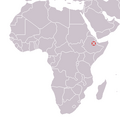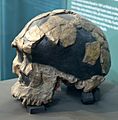Homo sapiens idaltu facts for kids
Quick facts for kids Archaic HumansTemporal range: Pleistocene
|
|
|---|---|
| Scientific classification | |
| Kingdom: | |
| Class: | |
| Order: | |
| Family: | |
| Subfamily: | |
| Genus: | |
| Species: | |
| Trinomial name | |
| †Homo sapiens idaltu White et al., 2003
|
|
Homo sapiens idaltu was a type of ancient human. They are an extinct subspecies of Homo sapiens. This means they were a bit different from modern humans, but still part of the same species. They lived in Africa about 160,000 years ago. This was during a time called the Pleistocene period, also known as the Ice Age. The name Idaltu comes from the Afar language. It means "elder" or "first born."
Contents
Discovering Ancient Humans
Where Were They Found?
The fossilized remains of H. s. idaltu were found in Ethiopia. This happened in 1997 in a place called the Afar Triangle. This area has many layers of volcanic rock. Scientists used a method called radiometric dating to find out how old these layers were. They found the layers were between 154,000 and 160,000 years old.
Three well-preserved parts of skulls, called crania, were discovered. The best one was from an adult male. This skull had a brain capacity of about 1,450 cubic centimeters. This is similar to the size of a modern human brain.
Even Older Discoveries
Later, an even older type of Homo sapiens was found. A team led by Richard Leakey discovered these remains. They were found in Omo National Park, also in Ethiopia.
In 2005, scientists used a dating method called potassium-argon dating. This method looked at volcanic rock near the remains. It showed that these Omo remains were about 195,000 years old. This makes them even older than the idaltu fossils.
These Omo remains are the earliest known fossils of "anatomically modern humans." This means they looked very much like people today. Leakey's team did not give these remains a special subspecies name. They are simply called "Omo remains of Homo sapiens."
Images for kids
See also
 In Spanish: Homo sapiens idaltu para niños
In Spanish: Homo sapiens idaltu para niños





